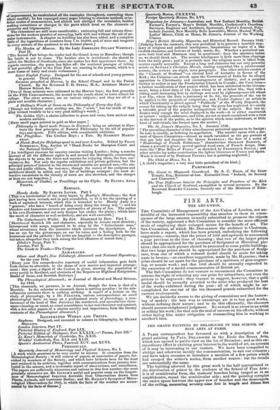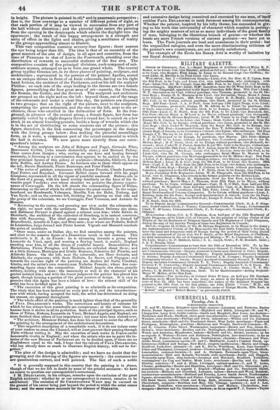rHE GRAND PAINTING BY DELAROCHE IN THE SCHOOL OF FINE ARTS AT PARIS.
A Penis correspondent has favoured us with a description of the grand painting by PAUL DELAROCHE in the Ecole des Beaux Arts, which was opened to public view on the 1st of Deember; and as this extraordinary effort is exciting great interest in the world of art, an account of it may be interesting to our readers. We have been compelled to abridge and otherwise modify the communication, to suit our columns ; and have taken occasion to introduce a mention of a few points which had escaped the writer's notice, from another source : but the details are substantially the same.
The building adorned by this great work is the hall appropriated to the distribution of prizes to the students of the School of Fine Arts : it is of semicircular form, the students' benches being ranged as in an amphitheatre, round the semicircular side ; and the painting occupies the entire space between the upper row of benches and the demicupola of the ceiling, measuring seventy-nine feet in length and fifteen feet in height. The picture is painted in oil,* and in panoramic perspective ; that is, the lines converge to a number of different points of sight, so that each portion of it may be viewed in succession from any part of the ball without distortion ; and the pictorial light enters the painting from the opening in the demicupola which admits the daylight into the apartment : the result of this happy arrangement is a strength and unity of effect in the lights and shades, giving a semblance of reality to the groups approaching almost to illusion. This vast composition contains seventy-four figures ; those nearest the eye being larger.than life. The idea is that of an assembly of the great masters of the arts of design, in all ages and countries, from the time of Peiticizs to that of Louis the Fourteenth, presiding over the distribution of rewards to successful students of the fine arts. The composition consists of five principal divisions, each composed of sub ordinate masses, arranged so as to form one grand whole. The central group typifies Grecian art, in its three phases of painting, sculpture, and architecture ; represented in the persons of the painter Apelles, seated on an antique throne in front of an Ionic colonnade, having on his right hand Ictinus, the architect of the Parthenon, and on his left the sculptor Phidias : on each side of the steps leading to the throne are two female figures, personifying the four great arras of art—namely, the Grecian, the Roman, the Gothic, and the Revival. The sculptors and architects are grouped on the right and on the left : beyond them, out of the range of the colonnade and under a clear blue sky, the painters are disposed in two groups ; that on the right of the picture, next to the sculptors, comprising the great colourists, and the one on the left, next to the ar chitects, those who excelled in the delineation of form. In the fore ground, in advance of the central group, a female figure, her form but partially veiled by a slight drapery thrown round her, is seated on a low stool, in an almost kneeling posture, beside a heap of wreaths which she is in the act of distributing to some students out of the picture : this figure, therefore, is the link connecting the personages in the design with the living groups below; thus making the pictorial assemblage fbrm, as it were, a component part of the actual ceremonial to which the hall is devoted. We now quote more directly from our correspondent's letter
" Among the sculptors are John of Bologna and Puget, Germain Pilon, Benvenuto Cellini, (who stands disdainfully alone,) and Bernard Palissy. Then comes Jean Goujon ; who, resting on one knee and leaning forward anxiously, is listening to a conversation that appears to be carried on by the four principal figures of this galaxy of sculptors-Donatello, Ghiberti, Lucca della Robbie, and Andrea Pisano. As listeners also to these chiefs appear on the left, Baccio Bandinelli, Pierre Bontemps, and Peter Fischer.
"The series of painters commences with Gaspar Poussin, Claude Lorraine, Paul Potter, and Ruysdael. Giovanni Bellied comes forward with his pupil
Giorgione, represented in all the vigour of youthful manhood. Rubens sits in the front of a group, with his hand resting familiarly on the knee of his favourite pupil Vandyke; over whose shoulder we perceive the gloomy cininte
mance of Caravaggio. On the left stands the "commanding figure of Titian,
discoursing on the art of which he still remains the great master. In the neighbourhood are Rembrandt, Velasquez, Murillo, Van der Helot, Terburg, and Van Eyck; and on the extreme left, finishing the painting on that side and the group of the colourists, we see Correggio, Paul Veronese, and Antonio da Messina.
"Returning to the centre, and pursuing our view under the colonnade on the right, we meet with the architects. Here Philibert Delorme sits alone, and &ides= Peruzzi is placed against a column near him; while Edwin de Steinbach, the architect of the cathedral of Strasburg, is in earnest converse tion with Sansovino. The chief group among the architects is formed b Brunelleschi, Arnolfo di Lapo, and Bramante; near whom are Palladio, Robert de Luzarches, Inigi)Jones,f and Pierre Lescot. Vignole and Mansard conclude the series. of architects.
"Once more, under an Italian sky, we find ourselves among the painters, and close to the massive figure of a Dominican monk in full costume. This ecclesiastic is B. A. da lieeole : he is advancing towards a group where
Leonardo da Vinci, aged, and wearing a flowing beard, is seated ; Raphael standing near him, in all the bloom of youthful beauty. Domenichino Fm Bartolomeo, Pietro Perugino, and Masaccio, are collected about them ; and
at a little distance, Mantegna and Giulio Romano, Sebastian del Piombo, and Albre-cht Darer. On the left, near the colonnade, are Marc Antonio, and
Edelinck, the engravers; with them Ilolbein, Le Sueur, and Orgagna; and
towards the extreme right of the painting arc Andrea del Sarto, Cimabue, Giotto, and the artist's own countryman Nicholas Poussin; whose fine com
manding figure closes the composition. Michael Angelo sits alone, grandly
solitary, herding with none : the immensity as well as the character of his genius Isolated him; and with the truest judgment the painter has placed him apart, though forming a portion of the great masters of design. It is easy to perceive that this figure has been a labour of love : the utmost skill of the artist his been lavished upon it. "The execution of this great painting is as admirable as its composition. The study that has been bestowed on every part of it, and the conscientiousness with which, having accepted the task, the artist has determined on doing his utmost, are apparent throughout. "The whole effect of the painting is much lighter than that of the generality Of PAUL DELAROCHE'S works. The correctness and beauty of costume for which he has always been remarkable are conspicuous ; at the same time, the human form is shown in all its perfection. Some of the principal figures, such as those of Titian, Rubens, Leonardo da Vinci, Michael Angelo, and Raphael, are more finished than others of less importance; but none have been slurred over. "The architect, Monsieur Duban, has done his utmost to assist the effect of the painting by the arrangement of the architectural decorations. "This imperfect description of a remarkable work, if it do not induce some of your readers to cross the Channel, will at least prevent their passing through Pans without visiting it. May the execution of such works in Francs excite honourable rivalry in England ; and when the artists who are to paint the interior of the new Houses of Parliament are to be decided upon, if there are no
Englishmen equal to the task, I hope that the talents of PAUL DELAROCHE, who has already done so much to illustrate English history, will not be forgotten." The plan of the design is admirable ; and we have no doubt that the grouping and the drawing of the figures are masterly : the costumes too are questionless correct, and well painted. The fact of such a noble
* It is generally supposed in this country that the painting is in fresco, though of that we are left in doubt by some of the printed accounts : we have no reason to question our correspondent's correctness. f M. DELEcLensr, in his critique, remarks upon the exclusion of the great English architect : whether he or our correspondent is correct, remains to be ascertained. The omission of Sir CHRISTOPHER WREN May be excused on the ground of his career being just beyond the period to which the artist comes down; and the same reason amounts for the absence of 1100ARTIL
and extensive design being conceived and executed by one man, of itself entitles Rem DELAROCHE to rank foremost among his contemporaries. Whether the painter, inspired by his lofty theme, has succeeded in giving to his work that universality of character which consists in portraying the mighty masters of art as so many individuals of the great family of man, belonging to the illustrious branch of genius—or whether the heads are mere French versions of current portraits—we have yet to learn. The Paris journals are loud and unanimous in their praise : but the unqualified eulogies, and even the more discriminating criticism of the painter's own countrymen, are not entirely satisfactory. The example of the Ecole des Beaux Arts is worthy of imitation by our Royal Academy.



























 Previous page
Previous page